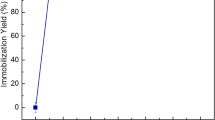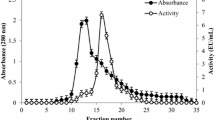Abstract
Phytase is used in poultry diets to hydrolyze and release of phytate-bound phosphorus. Immobilization on nanomaterials optimizes enzyme’s thermal stability and reusability. This study aimed to immobilize the recombinant phytase from Yersinia intermedia on the surface of amino-multi-walled carbon nanotubes (amino-MWCNTs) by physical adsorption. For this, zeta potential measurement, FTIR spectroscopic analysis, scanning electron microscope (SEM), kinetic as well as thermodynamic parameters were used to characterize immobilized phytase on amino-MWCNTs. According to results, the optimum temperature of the immobilized phytase increased from 50 to 70 °C and also thermal and pH stability improved considerably. Moreover, immobilization led to an increase in the value of Km and kcat from 0.13 to 0.33 mM and 2220 to 2776 s−1, respectively. In addition, the changes in activation energy of thermal inactivation (ΔE#a (D)), the free energy of thermal inactivation (ΔG#D) and the enthalpy of thermal inactivation (ΔH#D) for immobilized phytase increased by +11.05, +24.7 and +11.4 kj/mole, respectively, while the value of the change in the entropy of thermal inactivation (ΔS#D) decreased by − 0.04 kj/mole.K. Overall, our results showed that adsorption immobilization of phytase on amino-MWCNTs increases thermal, pH and storage stability as well as some of kinetic parameters.





Similar content being viewed by others
References
Angel R, Tamim N, Applegate T, Dhandu A, Ellestad L (2002) Phytic acid chemistry: influence on phytin-phosphorus availability and phytase efficacy. J Appl Poultry Res 11:471–480
Ushasree MV, Shyam K, Vidya J, Pandey A (2017) Microbial phytase: Impact of advances in genetic engineering in revolutionizing its properties and applications. Biores Technol 245:1790–1799
Tang J, Leung A, Leung C, Lim BL (2006) Hydrolysis of precipitated phytate by three distinct families of phytases. Soil Biol Biochem 38:1316–1324
Balwani I, Chakravarty K, Gaur S (2017) Role of phytase producing microorganisms towards agricultural sustainability. Biocatal Agric Biotechnol 12:23–29
Fredlund K, Isaksson M, Rossander-Hulthén L, Almgren A, Sandberg A-S (2006) Absorption of zinc and retention of calcium: dose-dependent inhibition by phytate. J Trace Elem Med Biol 20:49–57
Vohra A, Satyanarayana T (2003) Phytases: microbial sources, production, purification, and potential biotechnological applications. Crit Rev Biotechnol 23:29–60
Greiner R, Konietzny U, Jany K-D (1993) Purification and characterization of two phytases from Escherichia coli. Arch Biochem Biophys 303:107–113
Ashly P, Joseph M, Mohanan P (2011) Activity of diastase α-amylase immobilized on polyanilines (PANIs). Food Chem 127:1808–1813
Zahirinejad S, Hemmati R, Homaei A, Dinari A, Hosseinkhani S, Mohammadi S, Vianello F (2021) Nano-organic supports for enzyme immobilization: Scopes and Perspectives. Colloids Surf B Biointerfaces. https://doi.org/10.1016/j.colsurfb.2021.111774
Klibanov AM (1979) Enzyme stabilization by immobilization. Anal Biochem 93:1–25
Ashkan Z, Hemmati R, Homaei A, Dinari A, Jamlidoost M, Tashakor A (2020) Immobilization of enzymes on nanoinorganic support materials: an update. Int J Biol Macromol 168:708–721
Dong H, Li J, Li Y, Hu L, Luo D (2012) Improvement of catalytic activity and stability of lipase by immobilization on organobentonite. Chem Eng J 181:590–596
Hwang ET, Gu MB (2013) Enzyme stabilization by nano/microsized hybrid materials. Eng Life Sci 13:49–61
Kim J, Grate JW, Wang P (2006) Nanostructures for enzyme stabilization. Chem Eng Sci 61:1017–1026
O’connell MJ (2006) Carbon nanotubes: properties and applications. CRC Press, Baco Raton
Greiner R, Konietzny U, Blackburn DM, Jorquera MA (2013) Production of partially phosphorylated myo-inositol phosphates using phytases immobilised on magnetic nanoparticles. Biores Technol 142:375–383
Shankar S, Soni SK, Daima HK, Selvakannan P, Khire JM, Bhargava SK, Bansal V (2015) Charge-switchable gold nanoparticles for enhanced enzymatic thermostability. Phys Chem Chem Phys 17:21517–21524
Çelem EB, Önal S (2009) Immobilization of phytase on epoxy-activated Sepabead EC-EP for the hydrolysis of soymilk phytate. J Mol Catal B Enzym 61:150–156
Onem H, Cicek S, Nadaroglu H (2016) Immobilization of a thermostable phytase from Pinar melkior (Lactarius piperatus) onto magnetite chitosan nanoparticles. CYTA J Food 14:74–83
Kamaci UD, Peksel A (2020) Fabrication of PVA-chitosan-based nanofibers for phytase immobilization to enhance enzymatic activity. Int J Biol Macromol 164:3315–3322
Kamaci UD, Peksel A (2021) Enhanced catalytic activity of immobilized phytase into polyvinyl alcohol-sodium alginate based electrospun nanofibers. Catal Lett 151:821–831
Naghshbandi MP, Moghimi H, Latif B (2018) Covalent immobilization of phytase on the multi-walled carbon nanotubes via diimide-activated amidation: structural and stability study. Artif Cells Nanomed Biotechnol 46:763–772
Aoki K, Saito N (2020) Biocompatibility and carcinogenicity of carbon nanotubes as biomaterials. Nanomaterials 10:264
Huang H, Luo H, Yang P, Meng K, Wang Y, Yuan T, Bai Y, Yao B (2006) A novel phytase with preferable characteristics from Yersinia intermedia. Biochem Biophys Res Commun 350:884–889
Bradford MM (1976) A rapid and sensitive method for the quantitation of microgram quantities of protein utilizing the principle of protein–dye binding. Anal Biochem 72:248–254
Sambrook J, Fritsch E, Maniatis T (1989) Molecular cloning: a laboratory Manual, vol 3. Cold Spring Harbor Laboratory Press, Cold Spring Harbor
Mirzaei M, Saffar B, Shareghi B (2016) Cloning, codon optimization, and expression of Yersinia intermedia phytase gene in E coli. I J Biotechnol 14:63
de la Cruz EF, Zheng Y, Torres E, Li W, Song W, Burugapalli K (2012) Zeta potential of modified multi-walled carbon nanotubes in presence of poly (vinyl alcohol) hydrogel. Int J Electrochem Sci 7:3577–3590
Khoshnevisan K, Bordbar A-K, Zare D, Davoodi D, Noruzi M, Barkhi M, Tabatabaei M (2011) Immobilization of cellulase enzyme on superparamagnetic nanoparticles and determination of its activity and stability. Chem Eng J 171:669–673
Naidja A, Liu C, Huang P (2002) Formation of protein–birnessite complex: XRD, FTIR, and AFM analysis. J Colloid Interface Sci 251:46–56
Homaei A (2015) Enhanced activity and stability of papain immobilized on CNBr-activated sepharose. Int J Biol Macromol 75:373–377
Homaei AA, Mymandi AB, Sariri R, Kamrani E, Stevanato R, Etezad S-M, Khajeh K (2013) Purification and characterization of a novel thermostable luciferase from Benthosema pterotum. J Photochem Photobiol B 125:131–136
Homaei A (2015) Purification and biochemical properties of highly efficient alkaline phosphatase from Fenneropenaeus merguiensis brain. J Mol Catal B Enzym 118:16–22
Munch O, Tritsch D (1990) Irreversible thermoinactivation of glucoamylase from Aspergillus niger and thermostabilization by chemical modification of carboxyl groups. Biochim Biophys Acta Protein Struct Mol Enzymol 10:111–116
Siddiqui KS, Shemsi AM, Anwar MA, Rashid MH, Rajoka MI (1999) Partial and complete alteration of surface charges of carboxymethylcellulase by chemical modification: thermostabilization in water-miscible organic solvent. Enzyme Microb Technol 24:599–608
Homaei A, Etemadipour R (2015) Improving the activity and stability of actinidin by immobilization on gold nanorods. Int J Biol Macromol 72:1176–1181
Verma ML, Chaudhary R, Tsuzuki T, Barrow CJ, Puri M (2013) Immobilization of β-glucosidase on a magnetic nanoparticle improves thermostability: application in cellobiose hydrolysis. Biores Technol 135:2–6
Ji C, Nguyen LN, Hou J, Hai FI, Chen V (2017) Direct immobilization of laccase on titania nanoparticles from crude enzyme extracts of P. ostreatus culture for micro-pollutant degradation. Sep Purif Technol 178:215–223
Bayazidi P, Almasi H, Asl AK (2018) Immobilization of lysozyme on bacterial cellulose nanofibers: characteristics, antimicrobial activity and morphological properties. Int J Biol Macromol 107:2544–2551
Huang SH, Liao MH, Chen DH (2003) Direct binding and characterization of lipase onto magnetic nanoparticles. Biotechnol Prog 19:1095–1100
Coutinho TC, Tardioli PW, Farinas CS (2020) Phytase immobilization on hydroxyapatite nanoparticles improves its properties for use in animal feed. Appl Biochem Biotechnol 190:270–292
Acknowledgements
The authors wish to thank Shahrkord University for the use of facilities and financial support.
Author information
Authors and Affiliations
Corresponding author
Ethics declarations
Conflict of interest
The authors declare that they have no conflict of interest.
Additional information
Publisher's Note
Springer Nature remains neutral with regard to jurisdictional claims in published maps and institutional affiliations.
Rights and permissions
About this article
Cite this article
Lahiji, S., Hemmati, R., Homaei, A. et al. Improved thermal stability of phytase from Yersinia intermedia by physical adsorption immobilization on amino-multiwalled carbon nanotubes. Bioprocess Biosyst Eng 44, 2217–2228 (2021). https://doi.org/10.1007/s00449-021-02598-4
Received:
Accepted:
Published:
Issue Date:
DOI: https://doi.org/10.1007/s00449-021-02598-4




